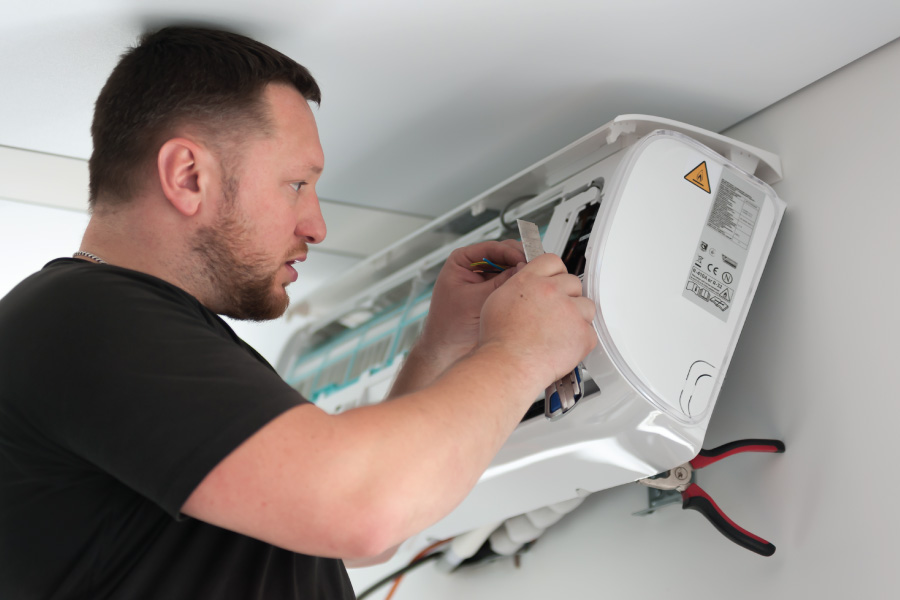Now is an ideal time to invest in air conditioning, as a new or more efficient model can save you up to 40% on cooling energy costs. We’re here to guide you through the preparation process and help you understand what to expect during an air conditioning installation, ensuring you’re ready for a cooler, more comfortable summer.
7 Steps for Preparing Your Home for Air Conditioner Installations
Gone are the days when air conditioning was a nicety to have; today, it’s essential to stay comfortably cool with the steady climb of rising Bozeman temperatures. If you’ve decided to invest in your home by installing air conditioning, there are a few steps you can take to ensure a smooth installation process. So, whether you’re certain about installation or still considering it, preparing your home properly prior to installation can make all the difference.
1. Partner with an HVAC Professional
When it comes to air conditioning installation, the most important decision you can make is hiring the right Bozeman HVAC contractors. A lot can go wrong in the hands of an inexperienced contractor, and there can be red flags you need to watch out for to ensure your air conditioner installation goes as smoothly as possible. You should schedule a consultation with an experienced HVAC professional to assess whether they are the best fit for your needs. The HVAC contractor you choose should be certified, knowledgeable, and reliable so you don’t waste your time with inefficient contractors that can cost you additional time, money, and headaches. A solid, reputable HVAC contractor shouldn’t hesitate to provide you with proof of insurance and licensure. They will assess your specific needs and recommend the most suitable air conditioning system for your home.], aiding in a streamlined installation process.
2. Check for Proper Insulation
Proper insulation is crucial for maximizing the efficiency of your new air conditioning system. Before installation, work with your HVAC contractor to inspect your home’s insulation, particularly in the attic and walls, to ensure it meets recommended standards. Poor insulation can lead to significant energy loss, making your air conditioner work harder than it needs to, to cool your home. Inadequate insulation can increase your home’s energy costs. If necessary, add or upgrade your home’s insulation to create a more energy-efficient environment. This step not only enhances the performance of your air conditioner, it will also contribute to your home’s overall energy savings.
3. Clear the Installation Area
Whether your air conditioning system is installed outside your home, within a utility closet, or underneath in a crawl space, it’s a good idea to clear the installation area from any obstructions. Outdoor debris or unnecessary clutter or obstacles could impede technicians from gaining access to the spot.
If an AC unit is being installed within your home, remove furniture and personal belongings from the area. Store them away from the route that contractors might use to reach the space. That way they can easily come and go as needed during the installation process. If an AC unit is installed outside the premises, clear away any obstacles that could get in the way, such as shrubbery or debris. An unobstructed path makes it easier for technicians to do their jobs efficiently without having to maneuver around barriers.
4. Assess Your Home’s Ductwork
The condition of your ductwork plays a significant role in the efficiency of your air conditioning system. Before installation, have your HVAC contractor inspect your ducts for any leaks, blockages, or damage. Sealing leaks and cleaning the ducts before installation can improve your home’s airflow and ensure that your new air conditioner operates at peak efficiency. Additionally, properly insulated ducts can prevent energy loss, helping to maintain consistent temperatures throughout your home. Addressing ductwork issues beforehand ensures that your new system functions optimally and delivers the desired cooling effect.
5. Choose the Best Air Conditioner Products
Prior to any air conditioner installations in your home, your HVAC contractor will work with you to help identify the best air conditioner products to meet your needs. Not only will this include choosing the best air conditioner size to cool your home effectively, it will also include double checking that your home has the proper electrical connections to support the AC system.
6. Ensure Proper Electrical Connections
Your HVAC contractor will check your home for existing electrical connections and determine if an electrician is needed to make any electrical modifications or necessary upgrades. Doing so will help safeguard your home from electrical issues that could arise from improper electrical connections to your AC unit.
7. Plan Ongoing Maintenance
Preparing for air conditioner installation also involves planning for its future maintenance. Regular maintenance, such as changing filters, cleaning coils, and checking refrigerant levels, is vital for keeping your system running efficiently. At Mountain Heating & Cooling we offer bronze, silver, gold, and platinum maintenance protection plans to keep your air conditioner running at its best. Establishing a maintenance routine from the start can prevent costly repairs, extend the lifespan of your air conditioner, and maintain its efficiency.
Air Conditioner Installations: What to Expect
Air conditioning installation is a complex process that you should never attempt yourself. That’s why we recommend hiring knowledgeable and certified professionals who can best understand your cooling needs and install the right air conditioner for your home. To begin, technicians will remove your home’s existing air conditioning system (if there is one). They will then safely reclaim and recycle any refrigerant and prepare the area for your new air conditioner unit. Once the area is prepared, technicians will then install the new unit. This includes installing evaporator coils, placing new copper refrigerant lines, and setting up a new air conditioner condenser. On average, air conditioner system installations take about eight hours in total.
After installing the air conditioner, technicians will remove old equipment, clean up the work area, and restore power and gas to the unit. At Mountain Heating & Cooling, as a Trane air conditioner specialist and Mitsubishi Dealer, we will walk you through the completed work and go over any special instructions, safety, and maintenance questions you may have so you can feel confident in your air conditioner installation. We will then ensure your home is spotless before leaving.
Wondering Which Air Conditioning System Suits Your Home Best? Let us Lend a Hand!
As the Bozeman heat reaches its peak, keeping your home cool becomes essential for comfort. At Mountain Heating & Cooling, we specialize in air conditioner installations and are here to help you prepare your home for the summer weather. Let us help you get your home ready and provide you with a clear understanding of the air conditioning installation process. Our certified cooling professionals will assist you in selecting the best HVAC solution tailored to your needs, ensuring you stay cool and comfortable all summer long. Reach out and schedule an appointment for an air conditioning consultation today!

